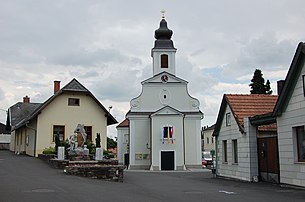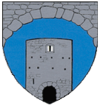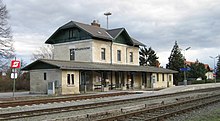Wöllersdorf-Steinabrückl
|
market community Wöllersdorf-Steinabrückl
|
||
|---|---|---|
| coat of arms | Austria map | |
|
|
||
| Basic data | ||
| Country: | Austria | |
| State : | Lower Austria | |
| Political District : | Wiener Neustadt-Land | |
| License plate : | WB | |
| Main town : | Woellersdorf | |
| Surface: | 14.55 km² | |
| Coordinates : | 47 ° 52 ' N , 16 ° 10' E | |
| Height : | 315 m above sea level A. | |
| Residents : | 4,631 (Jan 1, 2020) | |
| Population density : | 318 inhabitants per km² | |
| Postcodes : | 2752 (Wöllersdorf) 2751 (Steinabrückl) |
|
| Area code : | 02633 (Wöllersdorf) 02622 (Steinabrückl) |
|
| Community code : | 3 23 37 | |
| NUTS region | AT122 | |
| UN / LOCODE | AT WLL | |
| Address of the municipal administration: |
Market center 1 2752 Wöllersdorf |
|
| Website: | ||
| politics | ||
| Mayor : | Gustav Glöckler ( ÖVP ) | |
|
Municipal Council : ( 2020 ) (25 members) |
||
| Location of Wöllersdorf-Steinabrückl in the Wiener Neustadt-Land district | ||
 Parish church and war memorial |
||
| Source: Municipal data from Statistics Austria | ||
Wöllersdorf-Steinabrückl is a market town in the Wiener Neustadt-Land district in Lower Austria with 4631 inhabitants (as of January 1, 2020).
geography

Wöllersdorf-Steinabrückl is located in the industrial district in Lower Austria. The area of the market town covers 14.46 square kilometers. 43.2 percent of the area is forested.
Community structure
The municipality includes the following two localities (population in brackets as of January 1, 2020):
- Steinabrückl (2028)
- Woellersdorf (2603)
The community consists of the cadastral communities Steinabrückl and Wöllersdorf.
Map with all coordinates: OSM | WikiMap![]()
|
structure
|
Neighboring communities
history
The area of Wöllersdorf was settled in the Stone Age, this is proven by archaeological finds. Several jobs and a rare Stone Age kiln system were found dating back to the 6th and 5th millennium BC. BC and possibly also served for copper processing.
Before the birth of Christ, the area was part of the Celtic Kingdom of Noricum and belonged to the surroundings of the Celtic hill settlement Burg on the Schwarzenbacher Burgberg , which was the main town for the entire north-east Noricum . Later under the Romans, today's places Steinabrückl and Wöllersdorf were then in the province of Pannonia . The Celtic settlement is also documented by archaeological finds. Steinabrückl was a traffic junction in the prehistoric times. Since the Bronze Age, paths led from today's Burgenland to the Neolithic Salt Trail, which led from Vindobona to the Hall valley near Mariazell. The name of the place Wöllersdorf does not go back to the Slavic Welan, but is much older. Rather, it refers to the Indo-European "wella", i. H. Torrent. A rock barrier actually pulls through the place that dammed the Piesting River in prehistoric times. Steinabrückl also goes back to the Celtic “brig” = ford over a mountain or river. The initial stone has to do with a sacrificial stone, which was on a Piesting island. As was always falsely claimed, there was no Roman bridge over the Piesting. Steinabrückl has been the border point between the municipalities of Vindobona, Carnuntum and Scarbantia since Roman times. Under the Carolingians, the Piesting border was between the dioceses of Passau and Salzburg and, in the early Middle Ages, the lordly border between the Duchy of Carinthia and the "marca orientalis" = Austria. The first mention of Wöllersdorf was "Welanstorf" in 1156, the first documented mention in 1230. "Steinenbruck" was first mentioned in 1244. Until 1800 the place was assigned to four gentlemen. Fischau, Hernstein, Enzersfeld and the city of Wr. Neustadt.
After the Hungarian invasion in 1477, Steinabrückl was erased from the map for several years, and Wöllersdorf also fell victim to the Turkish siege in 1683 .
From 1815, systems for the production of rockets and explosives were built on the site between Wiener Neustadt and Wöllersdorf, initially under the name of the fireworks establishment. Later they were given the name Wöllersdorfer Werke . The water barracks was built to accommodate the production staff. Fireworks is still the name of a district today. During the First World War , the largest ammunition factory in the monarchy was located in Wöllersdorf . At least 382 people died in an explosion in this factory on September 18, 1918. At peak times, up to 40,000 people worked in the region's military industry. The Schneebergbahn was built in 1897 to supply supplies and due to the increase in tourism, after the Gutensteiner Bahn had already been built in 1878: the railway network within the factory and the connected large-scale means was over 100 km. In the factory itself there were repeated disasters of explosions, the worst in September 1914 when over 500 workers were killed.
During the Austro-Fascist period , the Wöllersdorf detention center for political prisoners was built on the site of the ammunition factory . After its dissolution, Wöllersdorf was renamed "Wöllersdorf-Trutzdorf" in 1938, and in 1945 it was renamed Wöllersdorf.
In 1972 the two independent communities Wöllersdorf and Steinabrückl were merged in the course of the Lower Austrian community reform and in 1988 raised to a market community .
In June 2005, graves from the Bronze Age and a cult site from the younger Iron Age were found in Wöllersdorf .
coat of arms
 Blazon : "In a blue shield a silver defensive tower growing out of the base of the shield with a black gate opening and black loopholes, which is elevated in the shield head by a silver square bridge."
Blazon : "In a blue shield a silver defensive tower growing out of the base of the shield with a black gate opening and black loopholes, which is elevated in the shield head by a silver square bridge."
The coat of arms was awarded on March 31, 1988. At the same time, the municipal colors "blue and white" set by the municipal council were approved.
Population development

religion
According to the data of the 2001 census , 67.0% of the population are Roman Catholic and 5.8% Protestant . 3.5% are Muslims , 2.6% belong to Orthodox churches . 17.8% of the population have no religious denomination.
politics
The municipal council has 25 members.
- With the municipal council elections in Lower Austria in 1990, the municipal council had the following distribution: 16 SPÖ and 7 ÖVP. (23 members)
- With the municipal council elections in Lower Austria in 1995, the municipal council had the following distribution: 13 SPÖ, 5 Independent Community Initiative, 4 ÖVP, and 1 FPÖ.
- With the municipal council elections in Lower Austria in 2000, the municipal council had the following distribution: 17 SPÖ, 3 ÖVP, 2 Independent Community Initiative, and 1 FPÖ.
- With the municipal council elections in Lower Austria in 2005 , the municipal council had the following distribution: 16 SPÖ, 5 ÖVP, and 2 Independent Community Initiative.
- With the municipal elections in Lower Austria in 2010 , the municipal council had the following distribution: 8 SPÖ, 5 ÖVP, 5 Wöllersdorf-Steinabrückl citizens' list, 3 FPÖ, and 2 Independent Community Initiative. (23 members)
- With the municipal elections in Lower Austria in 2015 , the municipal council had the following distribution: 16 ÖVP, 4 SPÖ, 2 Wöllersdorf-Steinabrückl citizens' list, 2 FPÖ, and 1 independent community initiative.
- With the municipal council elections in Lower Austria 2020 , the municipal council has the following distribution: 15 ÖVP, 5 SPÖ, 2 FPÖ, 2 Independent Community Initiative (UGI), 2 FPÖ and 1 Wöllersdorf-Steinabrückl citizens' list (BL).
- mayor
- until 2010 Marianne Straub (SPÖ)
- since 2010 Gustav Glöckler (ÖVP)
Culture and sights
- Cave tower ruin : The tower was built in the second half of the 15th century and served as protection against bands of robbers. Specifically, it is securing an underground cave. A part of this cave, the so-called “dance hall”, is still accessible today. After the renovation, the tower can now be entered again and offers a panoramic view of the place.
- Immaculate Monastery Wöllersdorf : The building was built as a mansion by the quarry owner Carl Vogel in 1842 and taken over by the Steyler Missionary Sisters in 1924 .
- Schlössl Wöllersdorf: built 1610–1710, served the Schmid von Schmidsfelden family as a residential building, completely renovated in 2002, today the community library is located in the building.
- Tatra Museum: 36 classic car exhibits can currently be viewed on a total of 700 square meters .
traffic
- Road: The community is crossed by the Süd Autobahn (A2), which runs from Vienna to the state border with Italy at Arnoldstein and has a junction in Wöllersdorf ("Wöllersdorf / Wr. Neustadt-Nord"). The Gutensteiner Straße (B21), which leads from Wiener Neustadt to Mariazell , runs through the local area of Wöllersdorf and Feuerwerkanstalt . A side branch (B21a) runs on the edge of the local area from Steinbrückl to Felixdorf , where it joins Wiener Neustädter Straße (B17).
- Railroad: With the Gutensteiner Bahn , the community has been accessible by rail since September 1, 1877. This had a train station in Wöllersdorf and a stop in Steinabrückl. With the construction of the Schneebergbahn , which built a wing section from Bad Fischau to Wöllersdorf, the Wöllersdorf station was built as a branch station on April 15, 1897, and another station was built in the Feuerwerkanstalt district. Wöllersdorf was also connected to Wiener Neustadt by rail. Due to the takeover of the Schneebergbahn by the Aspangbahn company, a connecting line from Sollenau (Aspangbahn) to the fireworks station was built, which began operations on August 27, 1900. This was linked to the Gutenstein Railway in Steinabrückl. The Feuerwerkanstalt station thus also became a branch station. As a result of the connection to the ammunition factories and storage facilities on Steinfeld, which had an extensive track network, the importance of the Feuerwerkanstalt station increased further, especially during the First World War . On May 4, 1947, the connecting line between Sollenau (Aspangbahnhof) and Steinabrückl and on May 28, 1972 that between Steinabrückl and the fireworks station was opened again. This made Steinabrückl train station a stopping and loading point. With the introduction of the new regular timetable in May 1991, passenger traffic between Wittmannsdorf and Wöllersdorf was discontinued, which means Steinabrückl lost its connection to Vienna. Since then, all traffic on the Gutensteiner Bahn has only run through Wiener Neustadt Hauptbahnhof .
economy
In 2001 there were 180 non-agricultural workplaces. In the 1999 survey, 29 agricultural and forestry holdings were counted. According to the 2001 census, the number of people in employment at the place of residence was 1,812. The employment rate in 2001 was 48.98 percent.
- Companies
- Wöllersdorf works
- The MABA Group operates a precast concrete plant with its own rail connection in a fireworks facility on an operating area of 175,911 square meters and a hall area of 26,000 square meters. The offices are located in the control room of the former Wöllersdorfer Werke power station.
Personalities
- Sons and daughters of the church
- Oscar Felsenfeld (1906–1978), Austrian-American pathologist and epidemiologist
- Adrian Hoven (1922–1981), Austrian actor
- Jakob Rosenfeld (1903–1952), Austrian general and doctor and minister of health under Mao Zedong
- Josef Staudigl (1807–1861) Austrian singer (bass)
- People related to the community
- Viktor Gernot (* 1965), Austrian cabaret artist ; grew up in Wöllersdorf
literature
- August Schmid: From the high times of the old Danube Monarchy. From the splendor and misery of its hammer lords . Self-published, Graz 1970, OBV .
- Ludwig Dörner (Ed.): Wöllersdorf. A home book . Wienerwald-Verlag, Bad Fischau, Mattersburg 1959, OBV .
- Reinhard Morawtz: Center for an agricultural community on the example of the community of Wöllersdorf-Steinabrückl near Wiener Neustadt . Thesis. Vienna University of Technology, Vienna 1975, OBV .
- Richard Zeitlhuber: House of a city dweller in a rural community. Theoretical investigation, carried out using the example of the municipality of Wöllersdorf, Lower Austria . o. O. 1975, OBV .
- Manfred Mannsberger: The art monuments of Wöllersdorf; the cultural heritage of 7,000 years of settlement . Mannsberger, Wöllersdorf 1978, OBV .
- Parish Wöllersdorf 1783–1983 . Parish office, Wöllersdorf 1983, OBV .
- Helmut Grüner: Wöllersdorf-Steinabrückl. Festschrift for the market survey and the award of the coat of arms [2. October 1988] . Market community, Wöllersdorf-Steinabrückl 1988, OBV .
- Karin Richter: The settlement development in the southern basin - from Wöllersdorf to Winzendorf - in the last decades . Thesis. Vienna University of Economics and Business, Vienna 1994, OBV .
- Festschrift and program for the celebration of 750 years of Steinabrückl . Market town of Wöllersdorf-Steinabrückl, Wöllersdorf-Steinabrückl 1994, OBV .
- Friedrich Hönigsperger: The old Wöllersdorf . Heimat-Verlag, Budapest, Schwarzach 2005, OBV .
- Friedrich Hönigsperger: The old Steinabrückl. A picture album with historical views . Heimat-Verlag, Schwarzach 2008, OBV .
Web links
- 32337 - Wöllersdorf-Steinabrückl. Community data, Statistics Austria .
- Statistical data from Wöllersdorf-Steinabrückl
- Tatra Museum
Individual evidence
- ↑ Statistics Austria: Population on January 1st, 2020 by locality (area status on January 1st, 2020) , ( CSV )
- ↑ Dorothea Talaa: The summer of 2013 - NGÖ in action . In: Network History Austria. Annual publication 2014. Volume 3. Kirchham bei Vorchdorf 2014. ISBN 978-3-200-03639-0 . Pp. 5-6.
- ↑ Dorothea Talaa: Celtic finds in the Vienna Basin. In: Network History Austria. Annual publication 2014. Volume 3. Kirchham bei Vorchdorf 2014. ISBN 978-3-200-03639-0 . Pp. 54-60.
- ↑ Kurt Bauer : We have nothing to fear . In: diepresse.com , March 28, 2008, accessed February 3, 2014.
- ^ ÖSTAT: Changes or definitions of community names from 1945 (accessed on April 24, 2017)
- ↑ Lower Austria state government: Announcement 24/88 of March 31, 1988 on the award of a coat of arms and the approval of the community colors for the community of Wöllersdorf-Steinabrückl (accessed on April 24, 2017)
- ^ Result of the local council election 1995 in Wöllersdorf-Steinabrückl. Office of the Lower Austrian State Government, March 30, 2000, accessed on September 27, 2019 .
- ^ Election result of the municipal council election 2000 in Wöllersdorf-Steinabrückl. Office of the Lower Austrian State Government, February 4, 2005, accessed on September 27, 2019 .
- ↑ Results of the 2005 municipal council elections in Wöllersdorf-Steinabrückl. Office of the Lower Austrian State Government, March 4, 2005, accessed on September 27, 2019 .
- ^ Election result of the municipal council election 2010 in Wöllersdorf-Steinabrückl. Office of the Lower Austrian State Government, October 8, 2010, accessed on September 27, 2019 .
- ^ Election result of the 2015 municipal council election in Wöllersdorf-Steinabrückl. Office of the Lower Austrian State Government, December 1, 2015, accessed on September 27, 2019 .
- ↑ Results of the municipal council election 2020 in Wöllersdorf-Steinabrückl. Office of the Lower Austrian state government, January 26, 2020, accessed on February 9, 2020 .
- ↑ MABA Precast Industry: Locations ( Memento of the original from March 11, 2012 in the Internet Archive ) Info: The archive link was inserted automatically and has not yet been checked. Please check the original and archive link according to the instructions and then remove this notice. (accessed on January 7, 2012)
- ^ W (illiam) Burrows: Oscar Felsenfeld - personal reminiscences . (English). In: Acta Tropica . Volume 36/1979, ISSN 0001-706X . Schwabe, Basel 1979, pp. 113-116. - online .








